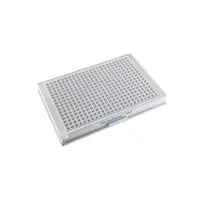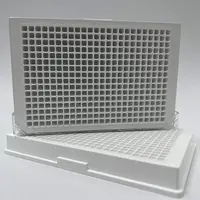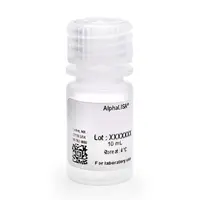
AlphaLISA Anti-methyl-Histone H3 Lysine 9 (H3K9me2) Acceptor Beads, 25 mg






AlphaLISA® Acceptor beads conjugated to an antibody against human histone H3 di-methylated at lysine 9 (H3K9me2). These beads can be used for no-wash AlphaLISA epigenetic writer and eraser assays.
For research use only. Not for use in diagnostic procedures. All products to be used in accordance with applicable laws and regulations including without limitation, consumption & disposal requirements under European REACH regulations (EC 1907/2006).
Product information
Overview
AlphaLISA® Acceptor beads designed to detect human Histone H3 di-methylated at lysine 9 (H3K9me2) in a homogeneous AlphaLISA assay. Broad species cross-reactivity is expected based on sequence similarity. Source of antibody: monoclonal.
The anti-methyl-Histone H3 Lysine 9 (H3K9me2) AlphaLISA Acceptor beads were used for the development and optimization of a G9a histone H3 methyltransferase assay using a biotinylated Histone H3(1-21) peptide as substrate. A technical note describing the assay is available in our product literature.
Features:
- No-wash epigenetic assay
- Fully-validated mark specificity
- Substrate flexibility (peptide, protein, histone, nucleosome substrates)
- Easy-to-automate
- Fast assay optimization
AlphaScreen® and AlphaLISA® are bead-based assay technologies used to study biomolecular interactions in a microplate format. The acronym "Alpha" stands for amplified luminescent proximity homogeneous assay. As the name implies, some of the key features of these technologies are that they are non-radioactive, homogeneous proximity assays. Binding of molecules captured on the beads leads to an energy transfer from one bead to the other, ultimately producing a luminescent/fluorescent signal. To understand how a signal is produced, one must begin with an understanding of the beads. AlphaScreen and AlphaLISA assays require two bead types: Donor beads and Acceptor beads. Each bead type contains a different proprietary mixture of chemicals, which are key elements of the AlphaScreen technology. Donor beads contain a photosensitizer, phthalocyanine, which converts ambient oxygen to an excited and reactive form of O2, singlet oxygen, upon illumination at 680 nm. Please note that singlet oxygen is not a radical; it is molecular oxygen with a single excited electron. Like other excited molecules, singlet oxygen has a limited lifetime prior to falling back to ground state. Within its 4 µsec half-life, singlet oxygen can diffuse approximately 200 nm in solution. If an Acceptor bead is within that proximity, energy is transferred from the singlet oxygen to thioxene derivatives within the Acceptor bead, subsequently culminating in light production at 520-620 nm (AlphaScreen) or at 615 nm (AlphaLISA). In the absence of an Acceptor bead, singlet oxygen falls to ground state and no signal is produced. This proximity-dependent chemical energy transfer is the basis for AlphaScreen's homogeneous nature.
Specifications
| Antibody Conjugates |
Anti-H3K9me2
|
|---|---|
| Application |
Epigenetics
|
| Automation Compatible |
Yes
|
| Bead Type or Material |
AlphaLISA Acceptor
|
| Brand |
AlphaLISA
|
| Detection Method |
Alpha
|
| Experimental Type |
In vitro
|
| Format |
Microplates
|
| Molecular Modification |
Methylation
|
| One Unit Contains |
25.0 mg
|
| Species |
Human
|
| Shipping Conditions |
Shipped in Blue Ice
|
| Unit Size |
25 mg
|
Video gallery


Resources
Alpha has been used to study a wide variety of interactions, including protein:protein, protein:peptide, protein:DNA, protein:RNA...

SDS, COAs, Manuals and more
Are you looking for technical documents for this product. We have housed them in a dedicated section., click on the links below to explore.


How can we help you?
We are here to answer your questions.




































